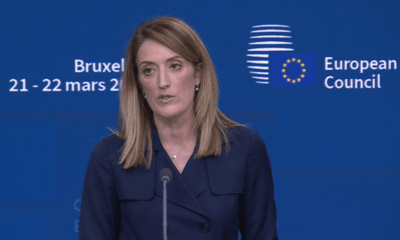Travel
UK Chancellor bets on third Heathrow Airport runway for boost to growth
Rachel Reeves’ support for a third runway came in a wide-ranging speech on boosting UK growth rates, which have been historically low since the 2008 global financial crisis for a variety of reasons.
Heathrow Airport’s plan to build a third runway at London’s main hub has been given a boost by Chancellor Rachel Reeves.
During a speech aimed at promoting growth for the UK and turning around the economy, Reeves said a third runway would bolster the country’s long-term economic growth prospects.
“We cannot duck the decision any longer,” she said. “The case is stronger than ever.”
Reeves said the government was inviting proposals over its construction by the summer and that it would then make a full assessment.
“This will ensure that the project is value for money and our clear expectation is that any associated service transport costs will be financed through private funding,” she said.
In her speech, Reeves insisted the runway will be “delivered in line with our legal, environmental and climate objectives”.
Reeves’ support for a third runway came in a wide-ranging speech on boosting UK growth rates, which have been historically low since the 2008 global financial crisis for a variety of reasons.
She also outlined plans for the building of nine new water reservoirs, pledged to create a Silicon Valley-like technology hub between the two university towns of Oxford and Cambridge, as well as a “reset” of the UK’s economic relations with the European Union, five years after Britain left the bloc.
The Labour government badly needs growth rates to increase over the coming years, so it can lift living standards following the cost-of-living crisis and to get money into ailing public services, as well as reduce the UK’s soaring public debt.
Something needs to be done for the economy
Since taking office in July, Reeves and Prime Minister Keir Starmer have been criticised for talking down the economy and for increasing taxes on business, a combination that critics argue have led to a growth downturn in the past few months and the sharp downturn in the government’s ratings in opinion polls.
Although a third runway won’t do much to bolster economic growth in the near-term, Reeves hopes that the announcement itself will provide investors with a signal that the government is serious about turning the economy around.
“We are not waiting for years into the future,” she said. “We want to do things now, to turn around the performance, and we want to give businesses and investors confidence that this is a country to start doing things, to start making things in again.”
It’s been a while coming
A third runway at Heathrow has been discussed since 1946 in the aftermath of World War II, but has never got off the ground because of many reasons, including changes of government as well as legal challenges. Meanwhile, other European hub airports, have grown. Paris’ Charles de Gaulle airport has four runways, while Amsterdam’s Schiphol has six.
Heathrow’s plan to build a third runway – which has been under discussion since 1946 in the aftermath of World War II – received parliamentary approval in June 2018. It was subsequently delayed by legal challenges, and the Covid pandemic.
Heathrow chief executive Thomas Woldbye had previously said he would not continue developing the project without the government confirming that it wanted expansion.
Woldbye described Reeves’ speech as “the bold, responsible vision the UK needs to thrive in the 21st century”.
Some investor scepticism
Commenting after the speech, Lindsay James, investment strategist at Quilter Investors said: “Today’s speech has also seen the re-emergence of plans to expand various UK airports, including Heathrow.
“It is debatable whether these airport developments are the right short-term target for growth and solving the UK’s productivity puzzle, and it is likely to spark strong opposition. These would no doubt be long-term projects which could take upwards of a decade to complete, and we could wait even longer for any real economic impact. There also appears to be no public funding to help spur on the plans, and the approval process could be another hurdle.
“Instead, the focus should be on upskilling the labour market and improving labour mobility through both the tax system and planning measures.”
Business supports plan but environment campaigners not happy
Business has long supported the creation of a third runway at Heathrow, which is operating at near full-capacity and which often means planes are left circling the capital before they can land.
Campaigners have for decades opposed a third runway on environmental concerns and Reeves’ announcement is likely to face vociferous opposition, including from fellow members of the governing Labour Party, including London Mayor Sadiq Khan.
The construction of a third runway will mean the demolition of more than 700 houses and parts of the key M25 motorway will have to be moved into a tunnel.
Travel
Finland, Montenegro, Albania: Which digital nomad visa in Europe has the lowest income requirement?
Spain has just increased its income requirements, but its digital nomad visa still isn’t one of the highest in Europe.
Foreigners in Spain who have a digital nomad visa or are thinking of applying for one this year will be subject to higher income requirements in 2025.
The monthly earning threshold is linked to Spain’s minimum wage – and the government has reached an agreement with the country’s main trade unions to increase this by 4.4 per cent this year.
This raise equates to €50 more per month, taking it up to €1,184 per month across 14 payments (€16,576 gross per year).
To understand how this translates for the digital nomad visa financial requirements, it has to be calculated as 12 payments of €1,381.33 per month.
Digital nomad visa applicants need to demonstrate that their monthly earnings are equal to 200 per cent of the minimum wage.
This means you now need to earn at least €2,762 per month to be eligible for the visa in 2025 – up more than €100 a month from last year.
Despite the increase in income requirements, Spain’s digital nomad visa still isn’t one of the highest in Europe.
Here’s how other European countries compare.
Iceland’s digital nomad visa has the highest income requirements
Iceland’s remote work long-term visa is aimed at high-income individuals earning €7,075 per month, the highest in Europe.
Workers can apply either as employees of a foreign company or as freelancers. The visa lasts for six months, and applicants are considered tax residents during this time.
Estonia comes in second, with applicants of the digital nomad visa requiring a gross monthly income of €4,500 a month. The visa lets people working remotely for companies abroad – or freelancers with clients mostly abroad – stay in Estonia for up to one year at a time.
If you remain in the country for more than six months, you will gain tax residency and be subject to local taxes.
Romania’s digital nomad visa, aimed at non-EU citizens, sets its income requirement at €3,950 per month, which is three times the country’s average gross salary.
In 2023, Romanian president Klaus Iohannis signed a new bill to clarify tax requirements for digital nomads. Those staying for long periods are exempt from paying income tax, social security, and social health insurance contributions.
Finland’s digital nomad visa has the lowest income requirements in Europe
Despite having high living costs, Finland requires digital nomad visa applicants to earn a minimum of just €1,220 per month.
Finland’s self-employment visa is open to non-EU entrepreneurs who are self-employed or run an independent business.
Montenegro’s requirements are also low, at around €1,400 per month. Participants can use the scheme to live in the country for up to four years. Digital nomads are eligible for tax breaks, although details are still to be confirmed.
Digital nomads can apply for an Albanian residence permit that allows them to stay and work in the country for up to one year. Introduced at the start of 2022, the so-called ‘Unique Permit’ can be renewed up to five times in a row.
Remote workers must show proof of an employment contract for a company outside of the country that allows them to work remotely, as well as proof of funds to support themselves of an estimated €9,800 a year.
Travel
Dubai is the world’s busiest airport, but is the tourism boom begining to strain the affluent city?
Dubai is welcoming more tourists than ever, but local residents don’t always benefit.
Dubai International Airport was the world’s busiest for international travel in 2024, officials announced on Thursday.
The hub saw a record 92.3 million passengers pass through its terminals last year.
The result cements Dubai’s bounce back from the coronavirus pandemic, surpassing the previous record set in 2018 for the first time.
It coincides with a real-estate boom and the city’s highest-ever tourism numbers, which have made Dubai a trending destination as well as a popular layover stop.
However, the city is now grappling with increasing traffic and housing costs, pressuring both its Emirati citizens and the foreign residents who power its economy.
Dubai Aiport was the world’s busiest in 2024
Today, Dubai International Airport feels like it is bursting at the seams with aircraft movements and crowds passing through its cavernous terminals.
Dubai’s ruler, Sheikh Mohammed bin Rashid Al Maktoum, announced the record number of passengers on the social media platform X.
The state-owned airport is home to the long-haul carrier Emirates, which powers the network of state-owned and state-linked businesses known as ‘Dubai Inc’.
“Dubai is the airport of the world […] and a new world in the aviation sector,” Sheikh Mohammed wrote.
In 2023, the airport, known as DXB, had 86.9 million passengers. Its 2019 traffic was 86.3 million passengers. It had 89.1 million passengers in 2018 – its previous busiest-ever year before the pandemic – while 66 million passengers passed through in 2022.
Dubai plans move to city’s second airport
In 10 years, authorities plan to move operations to the city-state’s second airport after a nearly $35 billion (€33.5 billion) upgrade.
Al Maktoum International Airport is roughly 45 kilometres away from DXB.
The airport, which opened in 2010 with one terminal and is known as DWC, served as a parking lot for Emirates’ double-decker Airbus A380s and other aircraft during the pandemic.
But since then, it has slowly returned to life with cargo and private flights. It also hosts the biennial Dubai Air Show and has a vast, empty desert in which to expand.
DXB and DWC serve 106 airlines flying to 272 cities in 107 countries across the world.
Dubai grapples with tourism boom
While tourism adverts continue to entice travellers to the city, the constant increase in arrivals is putting a strain on the local population and infrastructure.
Traffic on Dubai’s roads is becoming a nightmare for commuters. The price of housing continues to spike, even with new real estate projects being announced almost daily.
“Dubai is on steroids but affordability risks are increasing,” Hasnain Malik warned in a report for the global data firm Tellimer, where he’s a managing director.
Travel
Ryanair CEO lashes out at Spanish minister after blackmail accusations over seat cuts in 2025
Travellers will find fewer low-cost options at Spanish regional airports this summer.
European low-cost behemoth and one of the biggest budget airlines in the world, Ryanair has pulled thousands of seats from its schedules for 2025 across several Spanish airports.
In all, seven airports will have their Ryanair services reduced, some by as little as five per cent. Others will see the exit of the budget airline entirely.
Overall, Ryanair is removing a total of 800,000 seats from the Spanish market, representing 18 per cent of its overall operations in the country. Twelve routes will be lost altogether.
The airline says this is because of the fees imposed by Spanish airport operator Aena, which it deems ‘excessive.’ However, Aena has hit back at the airline, accusing it of ‘blackmail’ and suggesting that Ryanair is using its weight to try and get airport access for free.
“Unfortunately, this is Ryanair’s modus operandi,” says Maurici Lucena, President of Aena. “In many European countries, we have seen it for years: threats, half-truths, lies…; but in the case of Spain, I honestly believe that today they have crossed the Rubicon of respect, good faith and the most basic business and institutional courtesy.”
On Wednesday, the spat escalated after Ryanair CEO Michael O’Leary brought up another contentious incident.
In November 2024, the Spanish government fined five airlines for ‘abusive practices’ including charging passengers for carry-on luggage. Ryanair was hit with the biggest penalty of €107.8 million.
During a news conference in Brussels, O’Leary lambasted Spanish consumer rights minister Pablo Bustinduy, calling him “a crazy communist minister” who penalised airlines that “have no choice but to restrict carry-on bags”.
Bustinduy hit back saying that “no pressure, no blackmail and no insult will stop me” in his duty to defend the country’s consumers above multinationals and magnates, “however powerful they may be”, news site The Local reports.
Which airports are losing Ryanair service?
It is mainly regional airports in Spain that are losing either part or all of their Ryanair services.
Most affected are Jerez and Valladolid, which the budget airline will pull out of entirely.
According to Aena, Valladolid will be left with only one commercial operator once Ryanair exits – Binter Canarias, with its twice-weekly service to Gran Canaria.
Jerez will fare better, with existing services from Binter, Air Nostrum and Vueling connecting it to Madrid, Barcelona, Mallorca, Tenerife and Gran Canaria.
Of the other airports, Vigo will lose the most capacity, with Ryanair cutting 61 per cent of its flights.
At Santiago, Ryanair will remove one aircraft from its base there, leading to a 28 per cent reduction in capacity. Zaragoza, Asturias and Santander will also lose a few Ryanair flights.
“Aena’s excessive airport charges and lack of workable growth incentives continue to undermine Spain’s regional airports,” says Eddie Wilson, CEO of Ryanair. “As a result, Ryanair will cease its entire Jerez and Valladolid operations, remove 1 based aircraft from Santiago ($100m investment) and reduce traffic in Vigo, Santiago, Zaragoza, Asturias, and Santander (loss of 800,000 seats) in Summer 2025.”
What are the fees Ryanair is unhappy with?
Aena says that the average charge being paid by airlines for airport services as of 1 March will remain frozen at €10.35 per passenger, the same as it was in 2024.
“Aena’s refusal to incentivise airlines to use underutilised capacity at its regional airports has forced Ryanair to reallocate aircraft and capacity to more competitive European markets,” Wilson adds.
However, Aena disputes the assertion that they are not incentivising airlines to make use of regional airports. At the end of October 2024, the airport management company approved an initiative to stimulate growth by subsidising its 17 regional airports.
Specifically, for those airports with fewer than three million passengers and which had not returned to their pre-pandemic passenger levels, Aena has offered a 100 per cent discount for additional passengers over and above the 2023 levels.
Aena says that, in reality, this incentive scheme would reduce Ryanair’s per-passenger fee to just €2.
“Aena cordially urges Ryanair to calm down and abandon its long-standing and regrettably well-known mendacious, aggressive and threatening business and communication strategy,” the airport operator says, “which it is very difficult not to interpret as an attempt to blackmail Aena, the region and, ultimately, the Spanish public.”
Are the fees at Spanish airports hampering growth?
Aena says its fees are amongst the lowest in Europe, although Ryanair says this isn’t true.
Inflationary pressures have seen everything become more expensive, including in aviation. From fuel and staff to supplies and services, it all costs more than it used to and airlines have been quick to pass on to passengers.
The International Air Transport Association (IATA) says that airfares increased 16 per cent in 2024 compared with 2019. However, Airports Council International (ACI) has published research that suggests they’re more like 38 per cent higher.
On the other hand, airports have not been able to raise their charges to the same magnitude. ACI says that airport charges in Europe rose just 13.6 per cent in 2024, far below the cost increases airports are experiencing.
“Many airports have yet to fully reflect inflationary pressures in their user charges,” says Olivier Jankovec, director general of ACI Europe. “Regulators are often oblivious of these pressures and of how debt accumulated through COVID is hurting their investment capabilities.”
Part of Ryanair’s argument is that Aena was allowed to raise fees by 4.09 per cent in 2024, despite the Spanish government ruling in 2021 that airport fees would be frozen for five years.
In 2023, the Comisión Nacional de los Mercados y la Competencia (CNMC) approved the rise, which shakes out to a total of €0.40 more per passenger. Aena again proposed an increase for 2025, which would have added €0.05 to the cost for airlines, but it was refused by CNMC.
Despite Ryanair’s assertions that fees are at the heart of its schedule changes, the argument weakens when its entire Spanish operation is considered.
“I am surprised that they are questioning the profitability of these routes,” says Lucena. He goes on to explain that Ryanair’s flights from the regional airports have been full – fuller even than those at major city airports.
Throughout 2024, Ryanair increased its activity at Spanish airports by 8.7 per cent. For 2025, despite the cuts the airline has planned, its Spanish activities will increase again, with around 5 per cent more flights overall.
Ryanair is continuing to grow at the largest and most touristic Spanish airports. These airports do not attract the incentive discount, and airlines are charged the full €10.35 per passenger.
“In reality, what Ryanair has announced is that it will withdraw a very small percentage, in relative terms, of its total operations,” says Lucena. “The 800,000 seats they announced account for exactly 1.21 per cent of all passenger traffic they carried in 2024.”
He adds that Ryanair is masking business-led route cuts to exert pressure on Aena and the government.
Lucena even goes so far as to say that, under Spanish law, Ryanair’s moves could even be considered illegal. “In short, it’s all rather unpleasant and regrettable,” he concludes.
In a statement, Aena reiterated its position, saying, “Despite its grandiloquent rhetoric, Ryanair’s constant public pressure boils down to a simple goal: to use a significant portion of Spanish airports for free, which would jeopardise the long-term financial sustainability of Spain’s airport system.”
-

 EU & the World6 days ago
EU & the World6 days agoASAP Rocky’s Mom & Dad: All About His Parents
-

 Sports5 days ago
Sports5 days agoSerie A 2024-2025: Genoa-Monza, the likely lineups
-

 Politics6 days ago
Politics6 days agoDemocratic Republic of the Congo: Statement by the High Representative on behalf of the EU on the latest escalation in eastern DRC
-

 Politics6 days ago
Politics6 days agoRoberta Metsola – European Leadership And Political Representation
-

 Sports5 days ago
Sports5 days agoSerie C, round C, 2024-2025: Altamura-Taranto, the probable formations
-

 Sports6 days ago
Sports6 days agoBundesliga 2024-2025: St. Pauli-Union Berlin, the likely formations
-

 Sports4 days ago
Sports4 days agoLight-laser and firecracker throwing: maxi penalty for Napoli
-

 Politics6 days ago
Politics6 days agoYemen: Statement by the Spokesperson on the latest Houthi arbitrary detentions of UN personnel in Yemen








